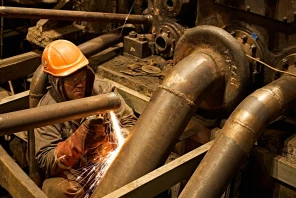The impacts of climate change are clear: our health is declining, we face a lot more natural disasters, and the future of our planet is unclear. What is clear is the need for a big shift in the system, today. A lower-carbon future is what can bring this shift to the masses. By adapting to low-carbon initiatives, humanity can attempt to battle global warming.
Let’s dive deeper into the topic to understand what the movement is and how we can reach the ultimate goal – a green future for the next generations.
What is a low-carbon future?
Fossil fuels, such as oil, coal, and gas, dominate all industries around the world. As a result of their use, the planet is encapsulated in greenhouse gases, and the temperatures are rising every day. More and more often, people have to cope with unpredictable weather events and natural disasters, including wildfires, tornadoes, and droughts.
The low-carbon future, however, can help stop these extremes. Reducing greenhouse gas emissions means we will transition to sources of renewable energy and live more sustainably. Humanity will adapt to new technology and enhance the overall quality of life.
Why is a low-carbon future important?
Below, we will break down the main benefits of this approach and explore how it will change our lives in the long term.
Environmental impact
The definition of a low carbon future always includes one clear motive – preserving our environment and ecosystem. Indeed, reducing greenhouse gas emissions will make it possible to restore the ecological systems we have already harmed. That encompasses:
- soil rehabilitation;
- ocean preservation;
- biodiversity protection.
All natural habitats could be protected, renewed, and the endangered species guarded. As natural disasters decline, we will see nature redevelop.
Economic benefits
The clean energy sector will develop more rapidly when we adhere to the low carbon emission strategy. That means the renewable energy industry will open its doors to existing and new professionals, motivating them to learn new net-zero emissions skills and gain more knowledge - the green economy.
Health and social advantages
Adapting to lower carbon energy will affect people’s health. With less air pollution, people will experience fewer respiratory issues, including asthma and chronic obstructive pulmonary disease (COPD). Cleaner air and more sustainable transport models will impact the quality of life in general. There will be less noise across the cities and more green spaces, leading to better mental health for residents.
Key pathways to achieving a low-carbon future
Imagine a world where the low-carbon economy is internationally respected and every power plant, production facility, business, and even individual adheres to certain rules. In the future, new technology and approaches will play a huge role. Here are the key pathways we should focus on.
Transition to renewable energy
Energy is the key to our existence. That is why the main focus should be on sustainable energy. Instead of non-renewables like coal, oil, and gas, we should be adopting renewable energy. Fossil fuels account for over 75% of global greenhouse gas emissions (according to the UN). So, to reach the low-carbon goals, we should move on to sun, wind, water.
Energy efficiency and conservation
Using less energy and utilising it more efficiently will reduce overall energy consumption. In that carbon-neutral economy, it will cut utility bills for everyone – businesses, cities, and individuals alike. Reduced energy use will help us battle global warming. As the demand for power decreases, we will depend on fossil fuels less.
Policy and regulatory measures
Promoting low-carbon measures is hard without regulation. Proper policies and rules should be established internationally to motivate global change. The governments should also provide proper supportive measures that will enhance the public’s trust in the new approach. Otherwise, the differences in policies and uncertainty can result in confusion and frustration among the masses.
Corporate sustainability initiatives
Businesses should invest in sustainable initiatives to adopt renewable energy and technology. Setting realistic aims and developing comprehensive plans are just a few ideas for corporate sustainability initiatives. In the long term, businesses will see the strengthening of their infrastructure and the growing number of investors and consumers.
Technological innovations
The current level of innovation is not enough to meet net-zero, but it is a concrete start to the low-carbon-footprint movement. Technical innovations are the cornerstones of green energy. With time, the transition will launch new projects, promote deeper research of the topic, and the demand will eventually be met.
Consumer and lifestyle changes
Not only businesses and production, but also consumers and individuals, will have to adapt to the new challenges of low carbon emissions. That means people will prefer electric vehicles and green public transport to fuel-powered cars. Flights will be less frequent and exchanged for road travel when possible. Individuals will have to adapt to green energy at home, investing in solar panels and maximising energy efficiency as much as possible.
Global initiatives and commitments to a low-carbon future
Governments, enterprises, and individuals have been increasingly starting and joining global initiatives to adhere to a carbon-free future. The Net Zero 2050 is the most famous commitment to date.
This initiative is proposing to cut carbon emissions to a minimum, where nature will be able to absorb and store them. Since the planet is already a lot warmer than it was in the late 1800s, the movement calls to limit the future temperature increase to 1.5°C above pre-industrial levels.
As of 2024, 107 countries responsible for the most greenhouse gas emissions had adopted the net-zero rules. More than 9,000 companies worldwide have also taken immediate action to cut emissions in half by 2023.
Frequently asked questions
- What is the difference between low-carbon and net-zero?
While net-zero and low carbon energy sources are the same, including wind and sun, the two approaches are slightly different. The former’s goal is to balance the amount of emissions with the amount removed from the atmosphere. The latter, on the other hand, aims to reduce carbon emissions to a minimum.
- How can individuals support a low-carbon future?
Individuals can start by transforming their own homes into efficient energy hubs. They can also stick to public and shared transport and fly less. Reusing and recycling electronics, produce, and clothes counts as a low-carbon effort, too.
- What are the economic benefits of a low-carbon transition?
The main economic benefit of the low-carbon approach is general growth. Low-carbon companies create millions of new employment opportunities, motivating workers to gain new skills and knowledge.







